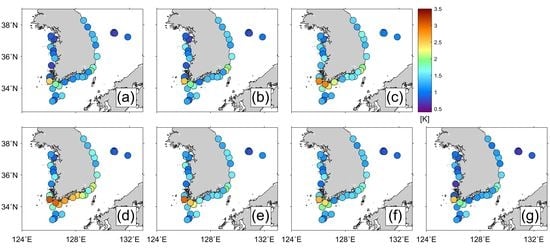Inter-Comparisons of Daily Sea Surface Temperatures and In-Situ Temperatures in the Coastal Regions
Abstract
1. Introduction
2. Data and Methods
2.1. SST Analysis Products
2.1.1. Met Office OSTIA SST Database
2.1.2. CMC SST Analysis Database
2.1.3. NCEI/NOAA OISST Database
2.1.4. REMSS Analysis Database
2.1.5. JPL/NASA MURSST Analysis Database
2.1.6. JMA MGDSST Analysis Database
2.1.7. NESDIS/NOAA Blended SST Analysis Database
2.2. In-Situ Temperature
2.3. Error Analysis Methodology
3. Results
3.1. Spatial Distribution of SST analyses
3.2. Comparison between SST Analysis Data and In-Situ Measurements
3.2.1. Accuracy Assessments of SST Databases
3.2.2. Characteristics of Spatial Distribution of SST Errors
3.2.3. Comparison of Wavelet Coherence
3.3. Inter-Comparison of the SST Products
3.3.1. Errors of Differences between the SST Products
3.3.2. Spatial Distribution of Variability between the SST Products
4. Discussion
4.1. Absence of Microwave SST at Coastal Region
4.2. Effect of Tidal Mixing and Upwelling
4.3. Effect of Front
4.4. Small Spatial Scale of Coastal Oceanic Features
5. Summary and Conclusions
Author Contributions
Funding
Acknowledgments
Conflicts of Interest
References
- Brasnett, B. A global analysis of sea surface temperature for numerical weather prediction. J. Atmos. Oceanic Technol. 1997, 14, 925–937. [Google Scholar] [CrossRef]
- Martin, M.J.; Hines, A.; Bell, M.J. Data assimilation in the FOAM operational short-range ocean forecasting system: A description of the scheme and its impact. Q. J. R. Meteorol. Soc 2007, 133, 981–995. [Google Scholar] [CrossRef]
- Chassignet, E.P.; Hurlburt, H.E.; Metzger, E.J.; Smedstad, O.M.; Cummings, J.; Halliwell, G.R.; Bleck, R.; Baraille, R.; Wallcraft, A.J.; Lozano, C.; et al. GODAE: Global Ocean Prediction with the HYbrid Coordinate Ocean Model (HYCOM). Oceanography 2009, 22, 64–75. [Google Scholar] [CrossRef]
- Donlon, C.J.; Martin, M.; Stark, J.; Roberts-Jones, J.; Fiedler, E.; Wimmer, W. The Operational Sea Surface Temperature and Sea Ice Analysis (OSTIA) system. Remote Sens. Environ. 2012, 116, 140–158. [Google Scholar] [CrossRef]
- Wentz, F.J.; Schabel, M. Precise climate monitoring using complementary satellite data sets. Nature 2000, 403, 414–416. [Google Scholar] [CrossRef] [PubMed]
- Casey, K.S.; Cornillon, P. Global and regional sea surface temperature trends. J. Clim. 2001, 14, 3801–3818. [Google Scholar] [CrossRef]
- Rayner, N.A.; Parker, D.E.; Horton, E.B.; Folland, C.K.; Alexander, L.V.; Rowell, D.P.; Kent, E.C.; Kaplan, A. Global analyses of sea surface temperature, sea ice, and night marine air temperature since the late nineteenth century. J. Geophys. Res. 2003, 108, 4407. [Google Scholar] [CrossRef]
- McPhaden, M.J. A 21st century shift in the relationship between ENSO SST and warm water volume anomalies. Geophys. Res. Lett. 2012, 39, L09706. [Google Scholar] [CrossRef]
- Park, K.-A.; Lee, E.-Y.; Chang, E.; Hong, S. Spatial and temporal variability of sea surface temperature and warming trends in the Yellow Sea. J. Mar. Syst. 2015, 143, 24–38. [Google Scholar] [CrossRef]
- Gledhill, D.K.; Wanninkhof, R.; Millero, F.J.; Eakin, M. Ocean acidification of the Greater Caribbean Region 1996–2006. J. Geophys. Res. 2008, 113, C10031. [Google Scholar] [CrossRef]
- Belkin, I.M. Rapid warming of large marine ecosystems. Prog. Oceanogr. 2009, 81, 207–213. [Google Scholar] [CrossRef]
- Cantin, N.E.; Cohen, A.L.; Karnauskas, K.B.; Tarrant, A.M.; McCorkle, D.C. Ocean warming slows coral growth in the central Red Sea. Science 2010, 329, 322–325. [Google Scholar] [CrossRef] [PubMed]
- Gittings, J.A.; Raitsos, D.E.; Krokos, G.; Hoteit, I. Impacts of warming on phytoplankton abundance and phenology in a typical tropical marine ecosystem. Sci. Rep. 2018, 8, 2240. [Google Scholar] [CrossRef] [PubMed]
- Solanki, H.U.; Dwivedi, R.M.; Nayak, S.R.; Somvanshi, V.S.; Gulati, D.K.; Pattnayak, S.K. Fishery forecast using OCM chlorophyll concentration and AVHRR SST: Validation results off Gujarat coast, India. Int. J. Remote Sens. 2003, 24, 3691–3699. [Google Scholar] [CrossRef]
- Mills, K.E.; Pershing, A.J.; Brown, C.J.; Chen, Y.; Chiang, F.S.; Holland, D.S.; Lehuta, S.; Nye, J.A.; Sun, J.C.; Thomas, A.C.; et al. Fisheries management in a changing climate: Lessons from the 2012 ocean heat wave in the Northwest Atlantic. Oceanography 2013, 26, 191–195. [Google Scholar] [CrossRef]
- Minnett, P.J.; Alvera-Azcárate, A.; Chin, T.; Corlett, G.; Gentemann, C.; Karagali, I.; Li, X.; Marsouin, A.; Marullo, S.; Maturi, E.; et al. Half a century of satellite remote sensing of sea-surface temperature. Remote Sens. Environ. 2019, 233, 111366. [Google Scholar] [CrossRef]
- Kilpatrick, K.A.; Podestá, G.P.; Evans, R. Overview of the NOAA/NASA advanced very high resolution radiometer Pathfinder algorithm for sea surface temperature and associated matchup database. J. Geophys. Res. 2001, 106, 9179–9197. [Google Scholar] [CrossRef]
- Corlett, G.K.; Barton, I.J.; Donlon, C.J.; Edwards, M.C.; Good, S.A.; Horrocks, L.A.; Llewellyn-Jones, D.T.; Merchant, C.J.; Minnett, P.J.; Nightingale, T.J.; et al. The accuracy of SST retrievals from AATSR: An initial assessment through geophysical validation against in situ radiometers, buoys and other SST data sets. Adv. Space Res. 2006, 37, 764–769. [Google Scholar] [CrossRef]
- O’Carroll, A.G.; Watts, J.G.; Horrocks, L.A.; Saunders, R.W.; Rayner, N.A. Validation of the AATSR meteo product sea surface temperature. J. Atmos. Ocean. Technol. 2006, 23, 711–726. [Google Scholar] [CrossRef]
- O’Carroll, A.G.; August, T.; Le Borgne, P.; Marsouin, A. The accuracy of SST retrievals from Metop-A IASI and AVHRR using the EUMETSAT OSI-SAF matchup dataset. Remote Sens. Environ. 2012, 126, 184–194. [Google Scholar] [CrossRef]
- Le Borgne, P.; Legendre, G.; Péré, S. Comparison of MSG/SEVIRI and drifting buoy derived diurnal warming estimates. Remote Sens. Environ. 2012, 124, 622–626. [Google Scholar] [CrossRef]
- Gentemann, C.L. Three way validation of MODIS and AMSR-E sea surface temperatures. J. Geophys. Res. Oceans 2014, 119, 2583–2598. [Google Scholar] [CrossRef]
- Castro, S.L.; Wick, G.A.; Emery, W.J. Evaluation of the relative performance of sea surface temperature measurements from different types of drifting and moored buoys using satellite-derived reference products. J. Geophys. Res. 2012, 117, C02029. [Google Scholar] [CrossRef]
- Smit, A.J.; Roberts, M.; Anderson, R.J.; Dufois, F.; Dudley, S.F.; Bornman, T.G.; Olbers, J.; Bolton, J.J. A coastal seawater temperature dataset for biogeographical studies: Large biases between in situ and remotely-sensed data sets around the coast of South Africa. PLoS ONE 2013, 8, e81944. [Google Scholar] [CrossRef] [PubMed]
- Brewin, R.J.W.; de Mora, L.; Billson, O.; Jackson, T.; Russell, P.; Brewin, T.G.; Shutler, J.; Miller, P.I.; Taylor, B.H.; Smyth, T.J.; et al. Evaluating operational AVHRR sea surface temperature data at the coastline using surfers. Estuar. Coast. Shelf Sci. 2017, 196, 276–289. [Google Scholar] [CrossRef]
- Hao, Y.; Cui, T.; Singh, V.P.; Zhang, J.; Yu, R.; Zhilei, Z. Validation of MODIS sea surface temperature product in the coastal waters of the Yellow Sea. IEEE J. Sel. Top. Appl. Earth Obs. Remote Sens. 2017, 10, 1667–1680. [Google Scholar]
- Brewin, R.; Smale, D.; Moore, P.; Dall’Olmo, G.; Miller, P.; Taylor, B.; Smyth, T.; Fishwick, J.; Yang, M. Evaluating operational AVHRR sea surface temperature data at the coastline using benthic temperature loggers. Remote Sens. 2018, 10, 925. [Google Scholar] [CrossRef]
- Chelton, D.B.; Wentz, F.J. Global microwave satellite observations of sea surface temperature for numerical weather prediction and climate research. Bull. Am. Meteorol. Soc. 2005, 86, 1097–1115. [Google Scholar] [CrossRef]
- Gentemann, C.L.; Wentz, F.J.; Brewer, M.; Hilburn, K.; Smith, D. Passive microwave remote sensing of the ocean: An overview. In Oceanography from Space; Barale, V., Gower, J.F.R., Alberotanza, L., Eds.; Springer: Hague, The Netherlands, 2010; pp. 13–33. [Google Scholar]
- Parkinson, C.; Ward, A.; King, M. Earth Science Reference Handbook: A Guide to NASA’s Earth Science Program and Earth Observing Satellite Missions; National Aeronautics and Space Administration: Washington, DC, USA, 2006.
- Brasnett, B. The impact of satellite retrievals in a global sea-surface-temperature analysis. Q. J. R. Meteorol. Soc. 2008, 134, 1745–1760. [Google Scholar] [CrossRef]
- Liu, Y.; Minnett, P.J. Evidence linking satellite-derived sea-surface temperature signals to changes in the Atlantic meridional overturning circulation. Remote Sens. Environ. 2015, 169, 150–162. [Google Scholar] [CrossRef]
- Gentemann, C.L.; Fewings, M.R.; García-Reyes, M. Satellite sea surface temperatures along the West Coast of the United States during the 2014–2016 northeast Pacific marine heat wave. Geophys. Res. Lett. 2017, 44, 312–319. [Google Scholar] [CrossRef]
- Ignatov, A.; Zhou, X.; Petrenko, B.; Liang, X.; Kihai, Y.; Dash, P.; Stroup, J.; Sapper, J.; DiGiacomo, P. AVHRR GAC SST Reanalysis Version 1 (RAN1). Remote Sens. 2016, 8, 315. [Google Scholar] [CrossRef]
- Sakurai, T.; Kurihara, Y.; Kuragano, T. Merged satellite and in-situ data global daily SST. In Proceedings of the 2005 IEEE International Geoscience and Remote Sensing Symposium (IGARSS), Seoul, Korea, 25–29 July 2005. [Google Scholar]
- Reynolds, R.W.; Smith, T.M.; Liu, C.; Chelton, D.B.; Casey, K.S.; Schlax, M.G. Daily high-resolution-blended analyses for sea surface temperature. J. Clim. 2007, 20, 5473–5496. [Google Scholar] [CrossRef]
- Martin, M.; Dash, P.; Ignatov, A.; Banzon, V.; Beggs, H.; Brasnett, B.; Cayula, J.F.; Cummings, J.; Donlon, C.; Gentemann, C.; et al. Group for High Resolution Sea Surface temperature (GHRSST) analysis fields inter-comparisons. Part 1: A GHRSST multi-product ensemble (GMPE). Deep Sea Res. II Top. Stud. Oceanogr. 2012, 77, 21–30. [Google Scholar] [CrossRef]
- Merchant, C.J.; Embury, O.; Roberts-Jones, J.; Fiedler, E.; Bulgin, C.E.; Corlett, G.K.; Good, S.; McLaren, A.; Rayner, N.; Morak-Bozzo, S.; et al. Sea surface temperature datasets for climate applications from Phase 1 of the European Space Agency Climate Change Initiative (SST CCI). Geosci. Data J. 2014, 1, 179–191. [Google Scholar] [CrossRef]
- Chin, T.M.; Vazquez-Cuervo, J.; Armstrong, E.M. A multi-scale high-resolution analysis of global sea surface temperature. Remote Sens. Environ. 2017, 200, 154–169. [Google Scholar] [CrossRef]
- Iwasaki, S.; Kubota, M.; Tomita, H. Inter-comparison and evaluation of global sea surface temperature products. Int. J. Remote Sens. 2008, 9, 6263–6280. [Google Scholar] [CrossRef]
- Reynolds, R.W.; Chelton, D.B. Comparisons of daily sea surface temperature analyses for 2007–08. J. Clim. 2010, 23, 3545–3562. [Google Scholar] [CrossRef]
- Dash, P.; Ignatov, A.; Martin, M.; Donlon, C.; Brasnett, B.; Reynolds, R.W.; Banzon, V.; Beggs, H.; Cayula, J.F.; Chao, Y.; et al. Group for high resolution sea surface temperature (GHRSST) analysis fields inter-comparisons. Part 2: Near real time web-based Level 4 SST quality monitor (L4-SQUAM). Deep Sea Res. II Top. Stud. Oceanogr. 2012, 77, 31–43. [Google Scholar] [CrossRef]
- Okuro, A.; Kubota, M.; Tomita, H.; Hihara, T. Inter-comparison of various global sea surface temperature products. Int. J. Remote Sens. 2014, 35, 5394–5410. [Google Scholar] [CrossRef]
- Castro, S.L.; Wick, G.A.; Steele, M. Validation of satellite sea surface temperature analyses in the Beaufort Sea using UpTempO buoys. Remote Sens. Environ. 2016, 187, 458–475. [Google Scholar] [CrossRef]
- Fiedler, E.K.; McLaren, A.; Banzon, V.; Brasnett, B.; Ishizaki, S.; Kennedy, J.; Rayner, N.; Roberts-Jones, J.; Corlett, G.; Merchant, C.J.; et al. Intercomparison of long-term sea surface temperature analyses using the GHRSST Multi-Product Ensemble (GMPE) system. Remote Sens. Environ. 2019, 222, 18–33. [Google Scholar] [CrossRef]
- Xie, J.; Zhu, J.; Yan, L. Assessment and inter-comparison of five high-resolution sea surface temperature products in the shelf and coastal seas around China. Cont. Shelf Res. 2008, 28, 1286–1293. [Google Scholar] [CrossRef]
- Choi, B.H.; Kim, K.O. Eum. H.M. Digital bathymetric and topographic data for neighboring seas of Korea (in Korean with English abstract). J. Korean Soc. Coastal Ocean Eng. 2002, 14, 41–50. [Google Scholar]
- Chang, K.-I.; Teague, W.; Lyu, S.; Perkins, H.; Lee, D.-K.; Watts, D.; Kim, Y.-B.; Mitchell, D.; Lee, C.; Kim, K. Circulation and currents in the southwestern East/Japan Sea: Overview and review. Prog. Oceanogr. 2004, 61, 105–156. [Google Scholar] [CrossRef]
- Park, K.-A.; Park, J.-E.; Choi, B.-J.; Byun, D.-S.; Lee, E.-I. An oceanic current map in the East Sea for science textbooks based on scientific knowledge acquired from oceanic measurements (in Korean with English abstract). J. Korean Soc. Oceanogr. 2013, 18, 234–265. [Google Scholar]
- Huh, O.K. Spring season flow of the Tsushima Current and its separation from the Kuroshio: Satellite evidence. J. Geophys. Res. 1982, 87, 9687–9693. [Google Scholar] [CrossRef]
- Park, K.-A.; Ullman, D.S.; Kim, K.; Chung, J.Y.; Kim, K.-R. Spatial and temporal variability of satellite-observed Subpolar Front in the East/Japan Sea. Deep Sea Res. I 2007, 54, 453–470. [Google Scholar] [CrossRef]
- Park, K.-A.; Woo, H.-J.; Ryu, J.-H. Spatial scales of mesoscale eddies from GOCI Chlorophyll-a concentration images in the East/Japan Sea. Ocean Sci. J. 2012, 47, 347–358. [Google Scholar] [CrossRef]
- Lie, H.J. Tidal fronts in the southeastern Hwanghae (Yellow Sea). Cont. Shelf Res. 1989, 9, 527–546. [Google Scholar] [CrossRef]
- Lee, S.H.; Beardsley, R.C. Influence of stratification on residual tidal currents in the Yellow Sea. J. Geophys. Res. 1999, 104, 15679–15701. [Google Scholar] [CrossRef]
- Kwon, M.; Jhun, J.G.; Wang, B.; An, S.I.; Kug, J.S. Decadal change in relationship between east Asian and WNP summer monsoons. Geophys. Res. Lett. 2005, 32, L16709. [Google Scholar] [CrossRef]
- Ha, K.J.; Heo, K.Y.; Lee, S.S.; Yun, K.S.; Jhun, J.G. Variability in the East Asian Monsoon: A review. Meteorol. App. 2012, 19, 200–215. [Google Scholar] [CrossRef]
- UK Met Office. GHRSST Level 4 OSTIA Global Foundation Sea Surface Temperature Analysis; Ver. 1.0; PO.DAAC: Pasadena, CA, USA, 2005. [CrossRef]
- Lorenc, A.C.; Bell, R.S.; Macpherson, B. The Meteorological Office analysis correction data assimilation scheme. Q. J. R. Meteorol. Soc. 1991, 117, 59–89. [Google Scholar] [CrossRef]
- Donlon, C.J.; Robinson, I.S. Observations of the oceanic thermal skin in the Atlantic Ocean. J. Geophys. Res. 1997, 102, 18585–18606. [Google Scholar] [CrossRef]
- Canada Meteorological Center. GHRSST Level 4 CMC0.2deg Global Foundation Sea Surface Temperature Analysis (GDS version 2); Ver. 2.0; PO.DAAC: Pasadena, CA, USA, 2012. [CrossRef]
- Banzon, V.; Smith, T.M.; Chin, T.M.; Liu, C.; Hankins, W. A long-term record of blended satellite and in situ sea surface temperature for climate monitoring, modeling and environmental studies. Earth Syst. Sci. Data 2016, 8, 165–176. [Google Scholar] [CrossRef]
- National Centers for Environmental Information. GHRSST Level 4 AVHRR_OI Global Blended Sea Surface Temperature Analysis (GDS version 2) from NCEI; Ver. 2.0; PO.DAAC: Pasadena, CA, USA, 2016. [CrossRef]
- Remote Sensing Systems. GHRSST Level 4 MW_IR_OI Global Foundation Sea Surface Temperature analysis version 5.0 from REMSS; Ver. 5.0; PO.DAAC: Pasadena, CA, USA, 2017. [CrossRef]
- JPL MUR MEaSUREs Project. GHRSST Level 4 MUR Global Foundation Sea Surface Temperature Analysis (v4.1); Ver. 4.1; PO.DAAC: Pasadena, CA, USA, 2015. [CrossRef]
- Kurihara, Y.; Sakurai, T.; Kuragano, T. Global daily sea surface temperature analysis using data from satellite microwave radiometer, satellite infrared radiometer and in--situ observations (in Japanese). Weath. Bull. 2006, 73, 1–18. [Google Scholar]
- Maturi, E.; Harris, A.; Mittaz, J.; Sapper, J.; Wick, G.; Zhu, X.; Dash, P.; Koner, P. A new high-resolution sea surface temperature blended analysis. Bull. Am. Meteorol. Soc. 2017, 98, 1015–1026. [Google Scholar] [CrossRef]
- Thiébaux, J.; Rogers, E.; Wang, W.; Katz, B. A new high resolution blended real-time global sea surface temperature analysis. Bull. Am. Meteorol. Soc. 2004, 84, 645–656. [Google Scholar] [CrossRef]
- Khellah, F.; Fieguth, P.W.; Murray, M.J.; Allen, M.R. Statistical processing of large image sequences. IEEE Trans. Image Process. 2005, 14, 80–93. [Google Scholar] [CrossRef]
- Korea Meteorological Administration. Monthly Report of Marine Data; Korea Meteorological Administration: Seoul, Korea, 2020; p. 701.
- Woo, H.-J.; Park, K.-A.; Li, X.; Lee, E.-Y. Sea surface temperature retrieval from the first Korean geostationary satellite COMS data: Validation and error assessment. Remote Sens. 2018, 10, 1916. [Google Scholar] [CrossRef]
- Jang, J.-C.; Park, K.-A.; Mouche, A.A.; Chapron, B.; Lee, J.-H. Validation of Sea Surface Wind from Sentinel-1A/B SAR Data in the Coastal Regions of the Korean Peninsula. IEEE J. Sel. Top. Appl. Earth Obs. Remote Sens. 2019, 12, 2513–2529. [Google Scholar] [CrossRef]
- Park, K.-A.; Chung, J.Y.; Kim, K. Sea surface temperature fronts in the East (Japan) sea and temporal variations. Geophys. Res. Lett. 2004, 31, L07304. [Google Scholar] [CrossRef]
- Park, K.-A.; Chung, J.-Y. Spatial and temporal scale variations of sea surface temperature in the East Sea using NOAA/AVHRR data. J. Oceanogr. 1999, 55, 271–288. [Google Scholar] [CrossRef]
- Kim, T.-S.; Park, K.-A.; Li, X.; Lee, M.; Hong, S.; Lyu, S.J.; Nam, S. Detection of the Hebei Spirit oil spill on SAR Imagery and its temporal evolution in a coastal region of the Yellow Sea. Adv. Space Res. 2015, 56, 1079–1093. [Google Scholar] [CrossRef]
- Kim, H.-Y.; Park, K.-A. Comparison of Sea Surface Temperature from Oceanic Buoys and Satellite Microwave Measurements in the Western Coastal Region of Korean Peninsula (in Korean with English abstract. J. Korean Earth Sci. Soc. 2018, 39, 555–567. [Google Scholar] [CrossRef]
- Saunders, R.W.; Kriebel, K.T. An improved method for detecting clear sky and cloudy radiances from AVHRR data. Int. J. Remote Sens. 1988, 9, 123–150. [Google Scholar] [CrossRef]
- Robinson, I.S. Measuring the Oceans from Space: The Principles and Methods of Satellite Oceanography; Springer Praxis Books in Geophysical Sciences: Berlin, Germany, 2004; p. 669. [Google Scholar]
- Merchant, C.; Harris, A.; Maturi, E.; MacCallum, S. Probabilistic physically based cloud screening of satellite infrared imagery for operational sea surface temperature retrieval. Q. J. R. Meteorol. Soc. 2005, 131, 2735–2755. [Google Scholar] [CrossRef]
- Choi, B.-H. A tidal model of the Yellow Sea and the Eastern China Sea; Korea Ocean Research and Development Institute: Ansan, Korea, 1980; p. 72. [Google Scholar]
- Park, K.-A.; Kim, K.-R. Unprecedented coastal upwelling in the East/Japan Sea and linkage to long--term large--scale variations. Geophys. Res. Lett. 2010, 37, L09603. [Google Scholar] [CrossRef]
- Kim, T.-S.; Park, K.-A.; Li, X.; Hong, S. SAR-derived wind fields at the coastal region in the East/Japan sea and relation to coastal upwelling. Int. J. Remote Sens. 2014, 35, 3947–3965. [Google Scholar] [CrossRef]
- Cho, Y.-K.; Kim, M.-O.; Kim, B.-C. Sea fog around the Korean peninsula. J. Appl. Meteor. 2000, 39, 2473–2479. [Google Scholar] [CrossRef]
- Tokinaga, H.; Xie, S.-P. Ocean tidal cooling effect on summer sea fog over the Okhotsk Sea. J. Geophys. Res. 2009, 114, D14102. [Google Scholar] [CrossRef]
- Miller, R.L.; del Castillo, C.E.; McKee, B.A. Remote Sensing of Coastal Aquatic Environments. Technologies, Techniques and Applications; Springer: New York, NY, USA, 2005. [Google Scholar]
- Tu, Q.; Pan, D.; Hao, Z. Validation of S-NPP VIIRS sea surface temperature retrieved from NAVO. Remote Sens. 2015, 7, 17234–17245. [Google Scholar] [CrossRef]
- Thomas, A.; Byrne, D.; Weatherbee, R. Coastal sea surface temperature variability from Landsat infrared data. Remote Sens. Environ. 2002, 81, 262–272. [Google Scholar] [CrossRef]
- Jang, J.-C.; Park, K.-A. High-resolution sea surface temperature retrieval from Landsat 8 OLI/TIRS data at coastal regions. Remote Sens. 2019, 11, 2687. [Google Scholar] [CrossRef]
- Medina-Lopez, E.; Ureña-Fuentes, L. High-resolution sea surface temperature and salinity in coastal areas worldwide from raw satellite data. Remote Sens. 2019, 11, 2191. [Google Scholar] [CrossRef]
- O’Carroll, A.G.; Armstrong, E.M.; Beggs, H.M.; Bouali, M.; Casey, K.S.; Corlett, G.K.; Dash, P.; Donlon, C.J.; Gentemann, C.L.; Hoeyer, J.; et al. Observational needs of sea surface temperature. Front. Mar. Sci. 2019, 6, 420. [Google Scholar] [CrossRef]
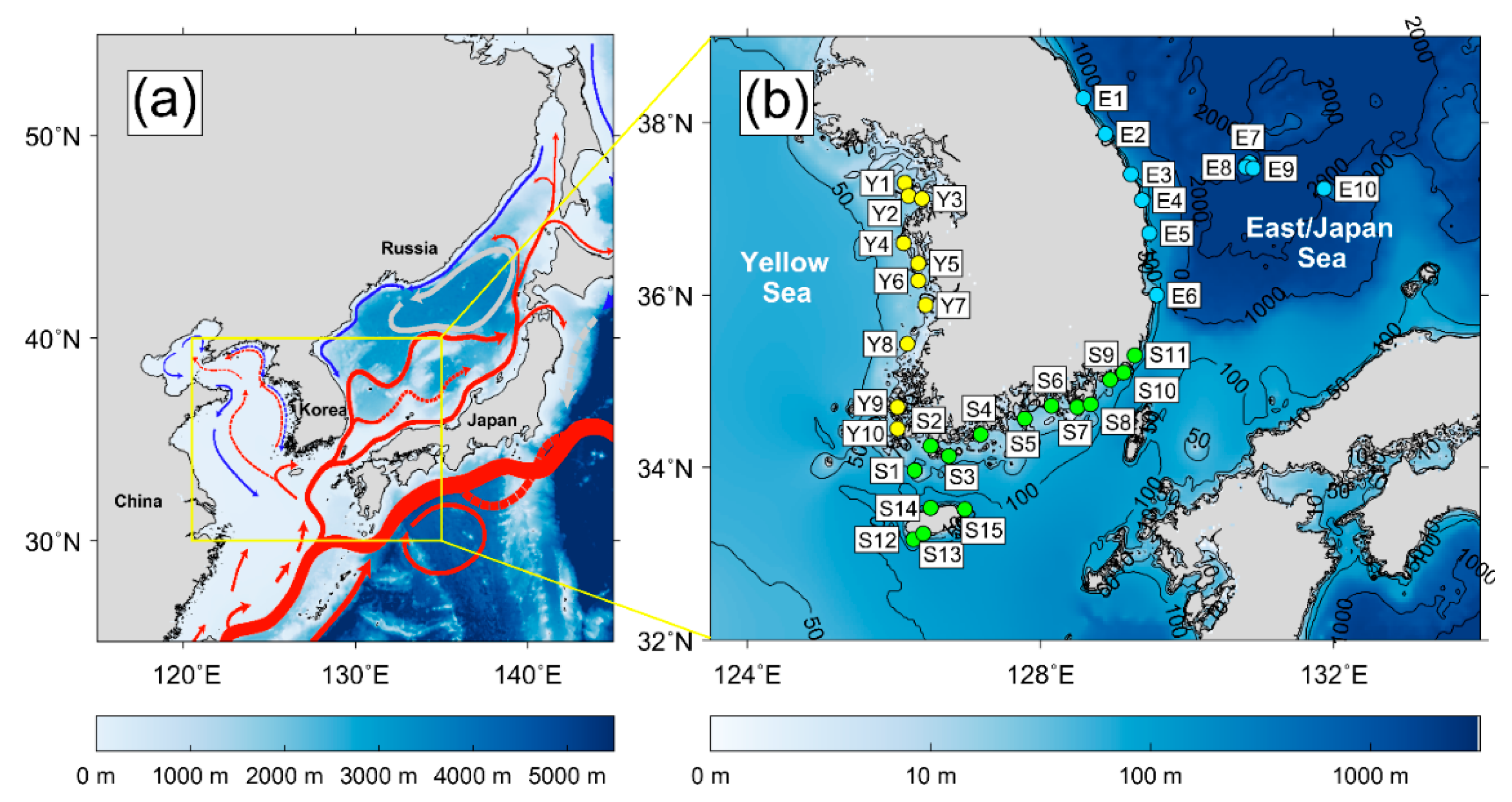
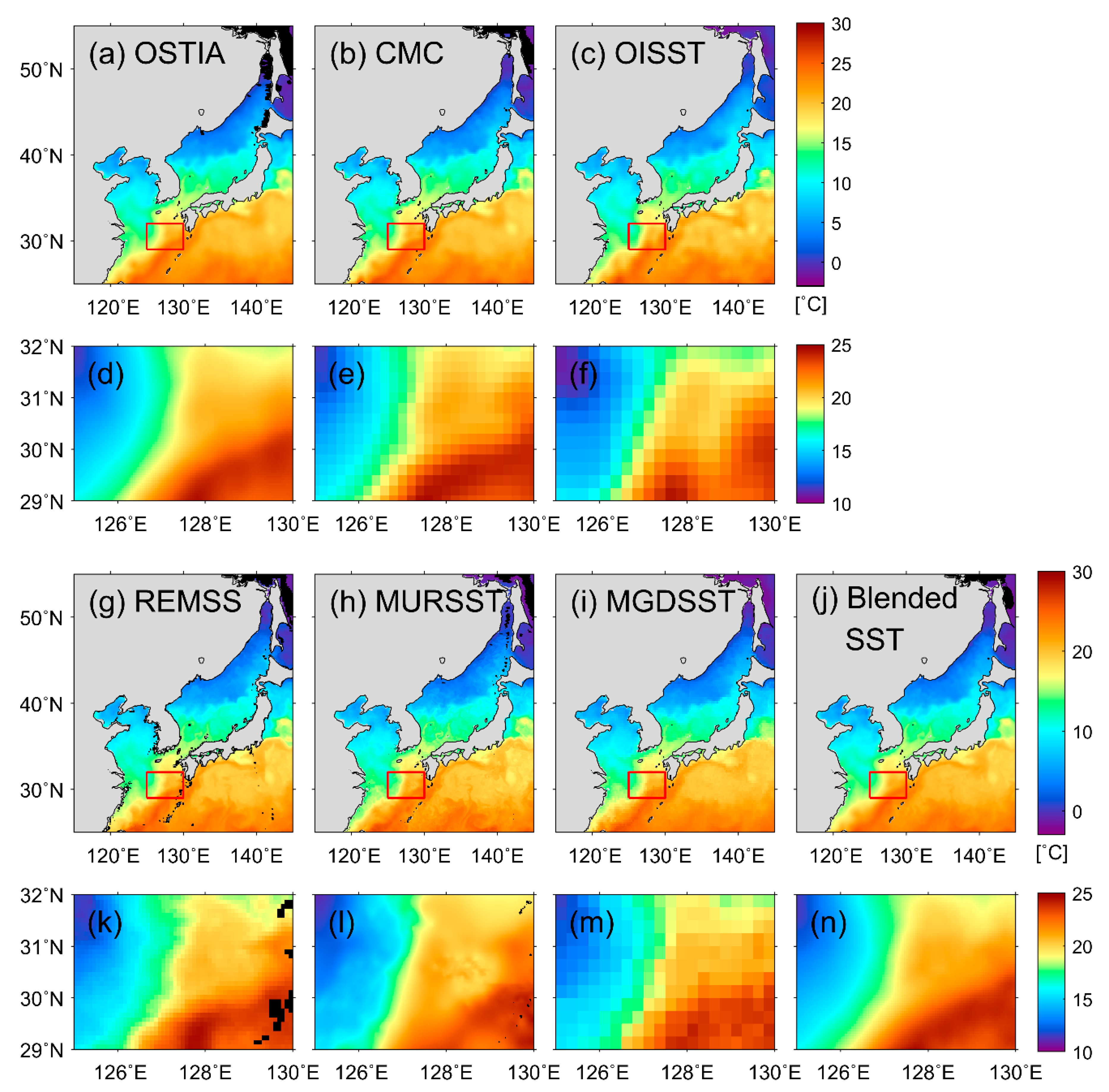
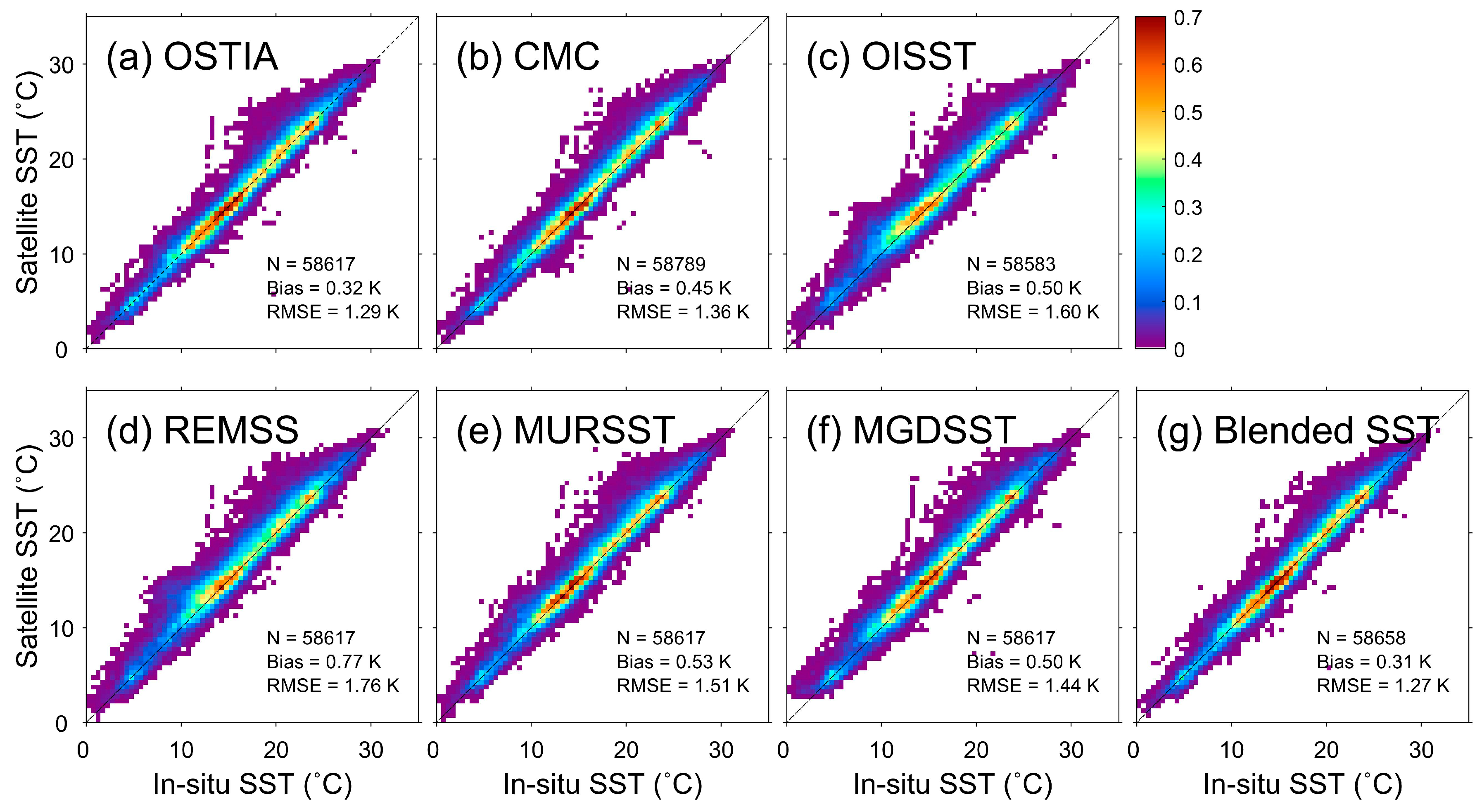
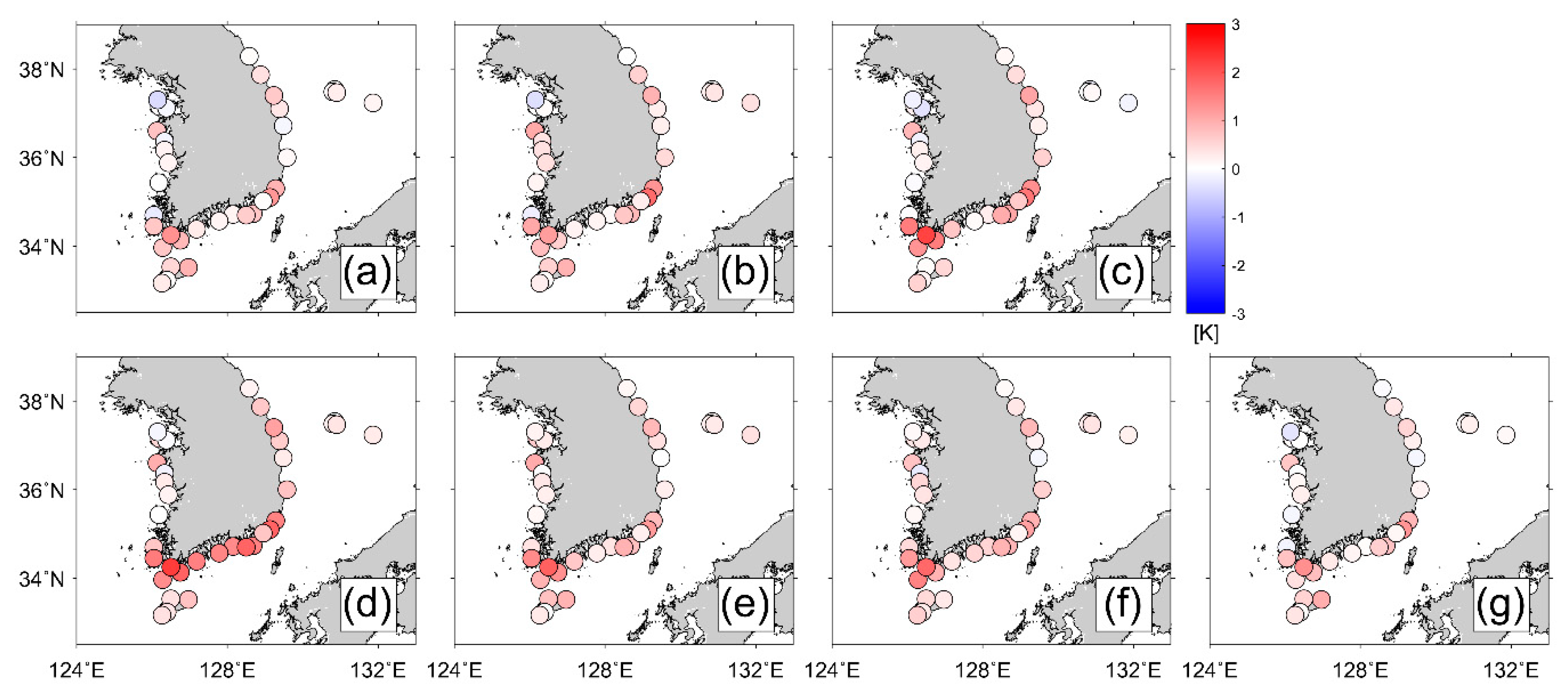
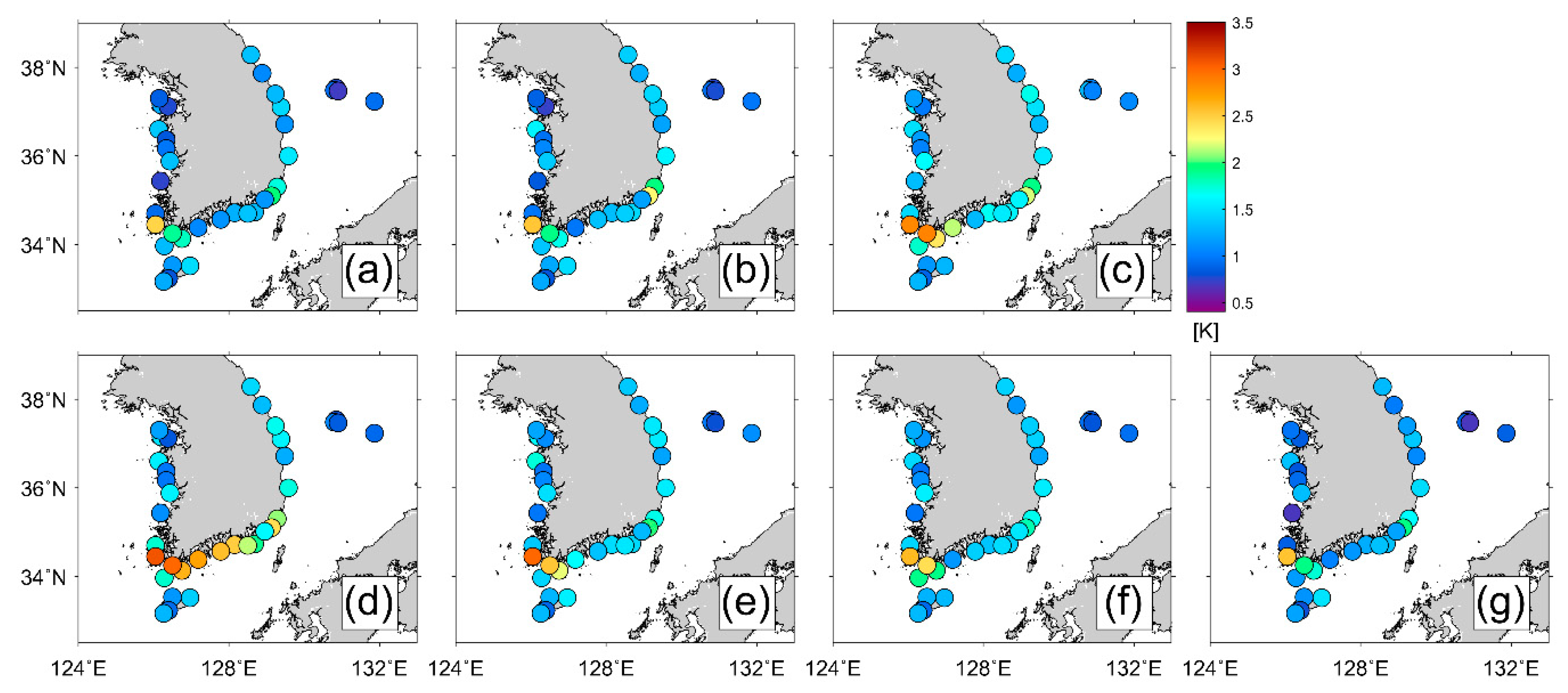
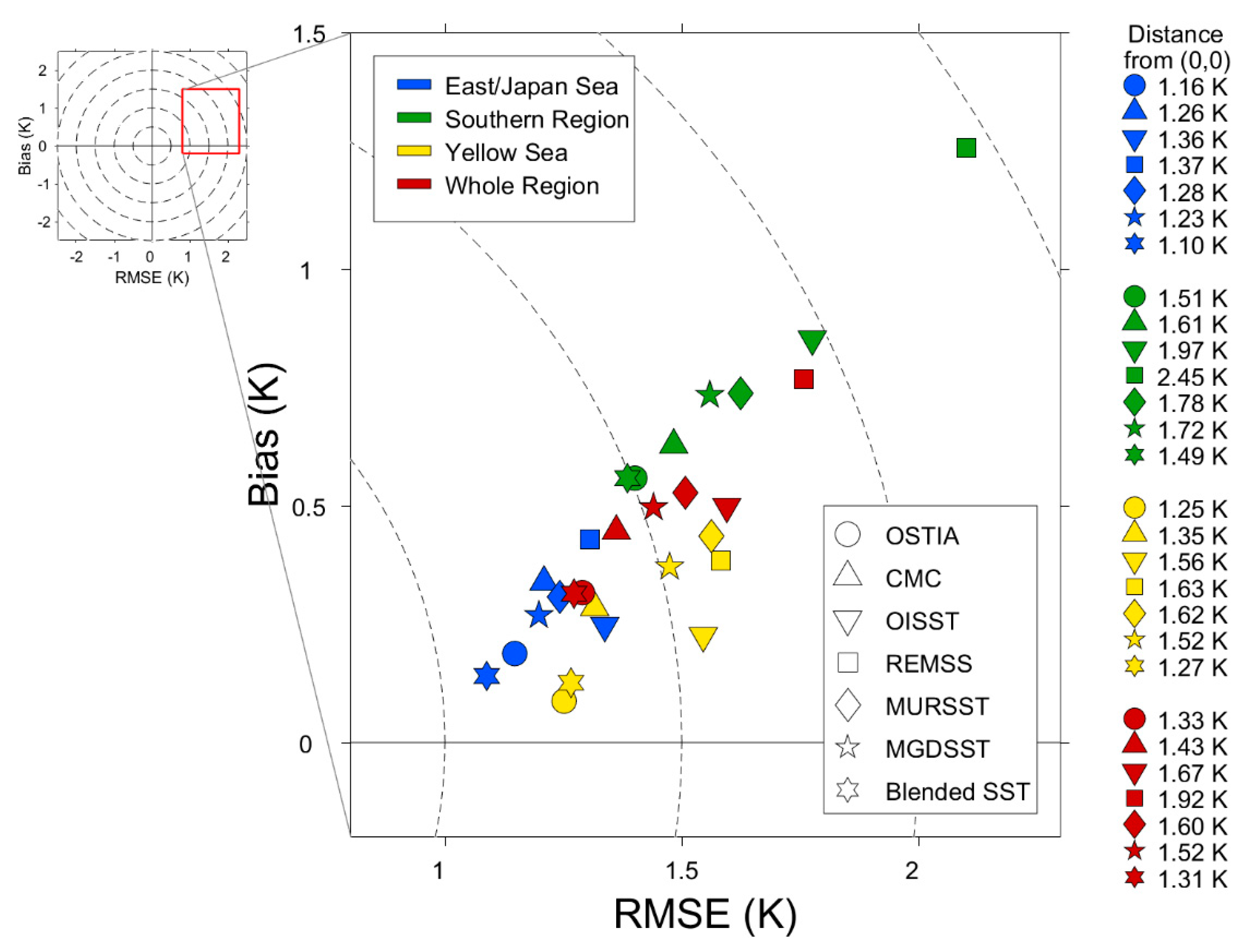
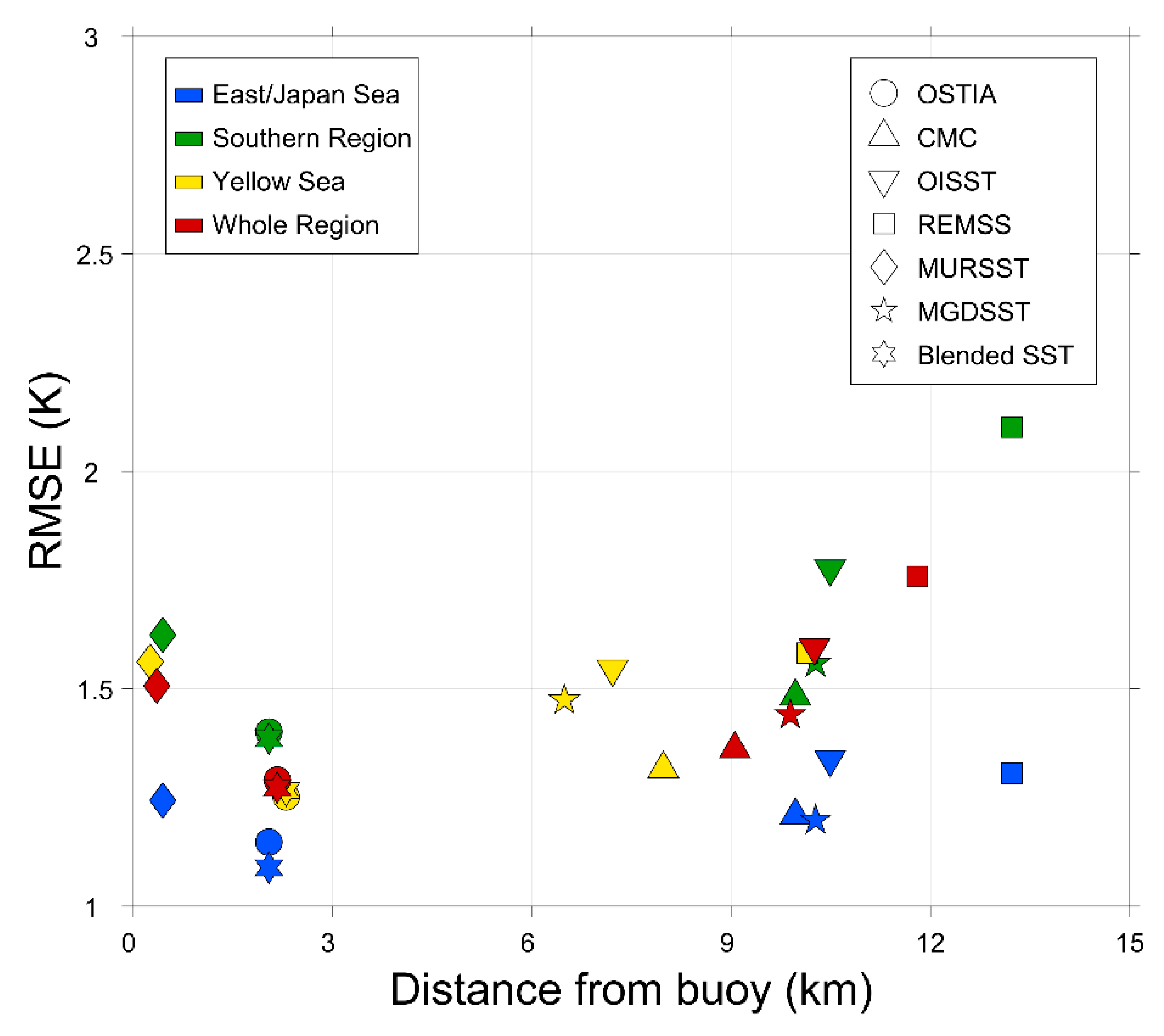
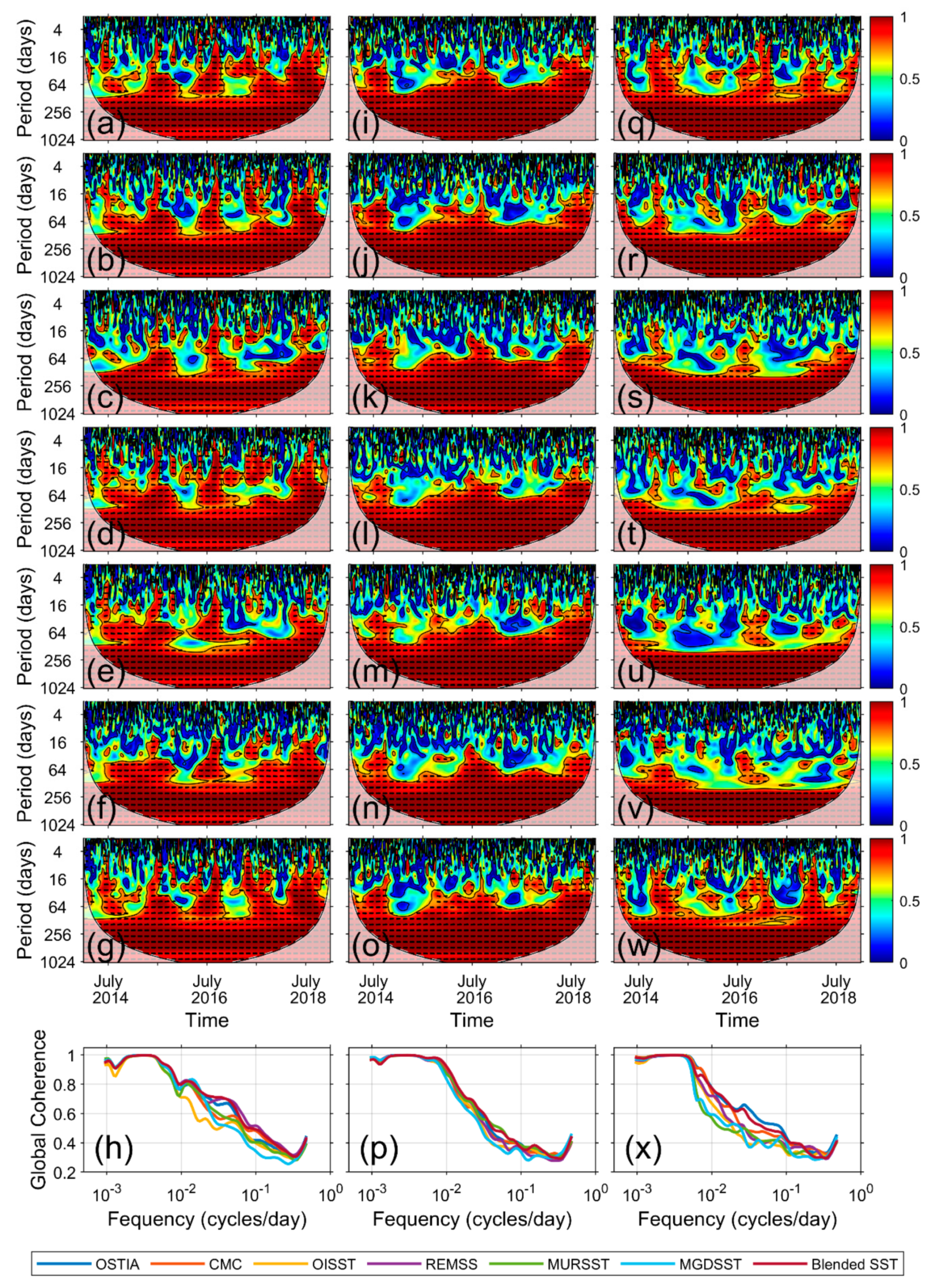
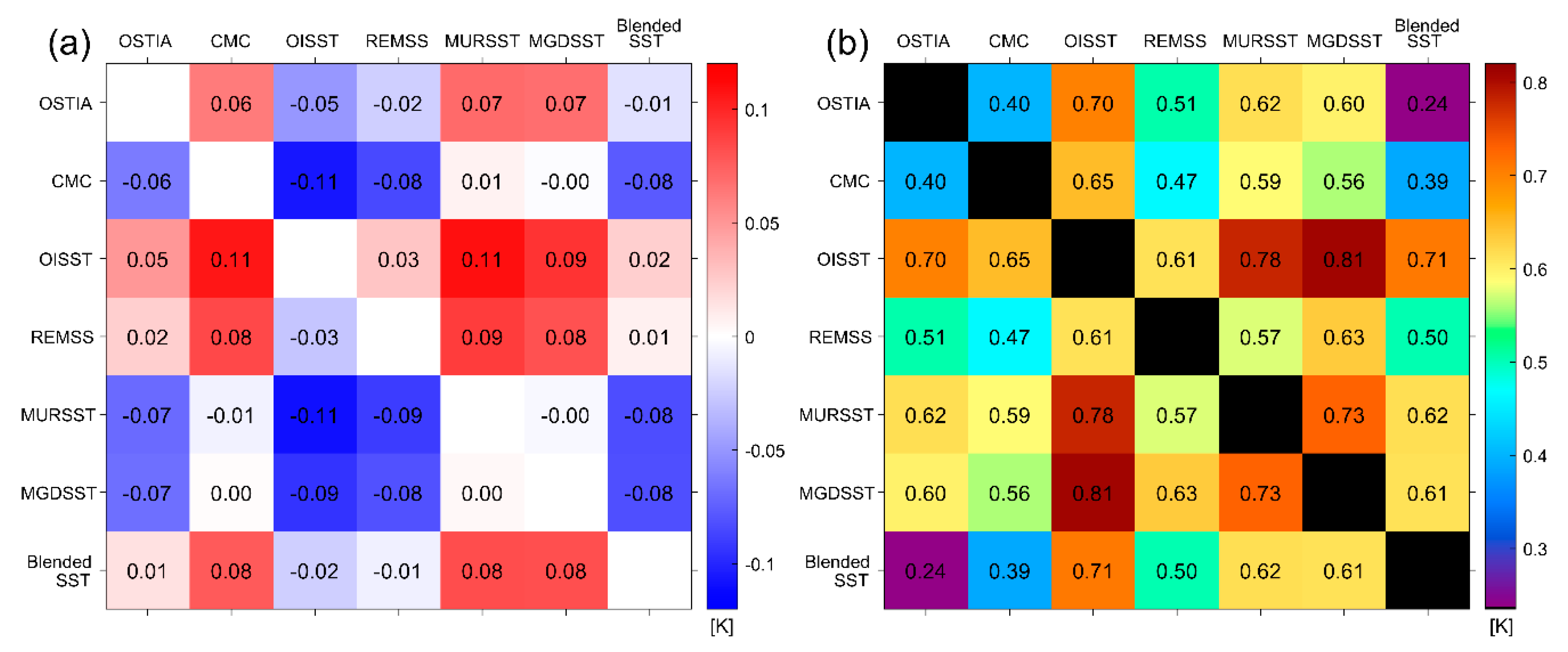
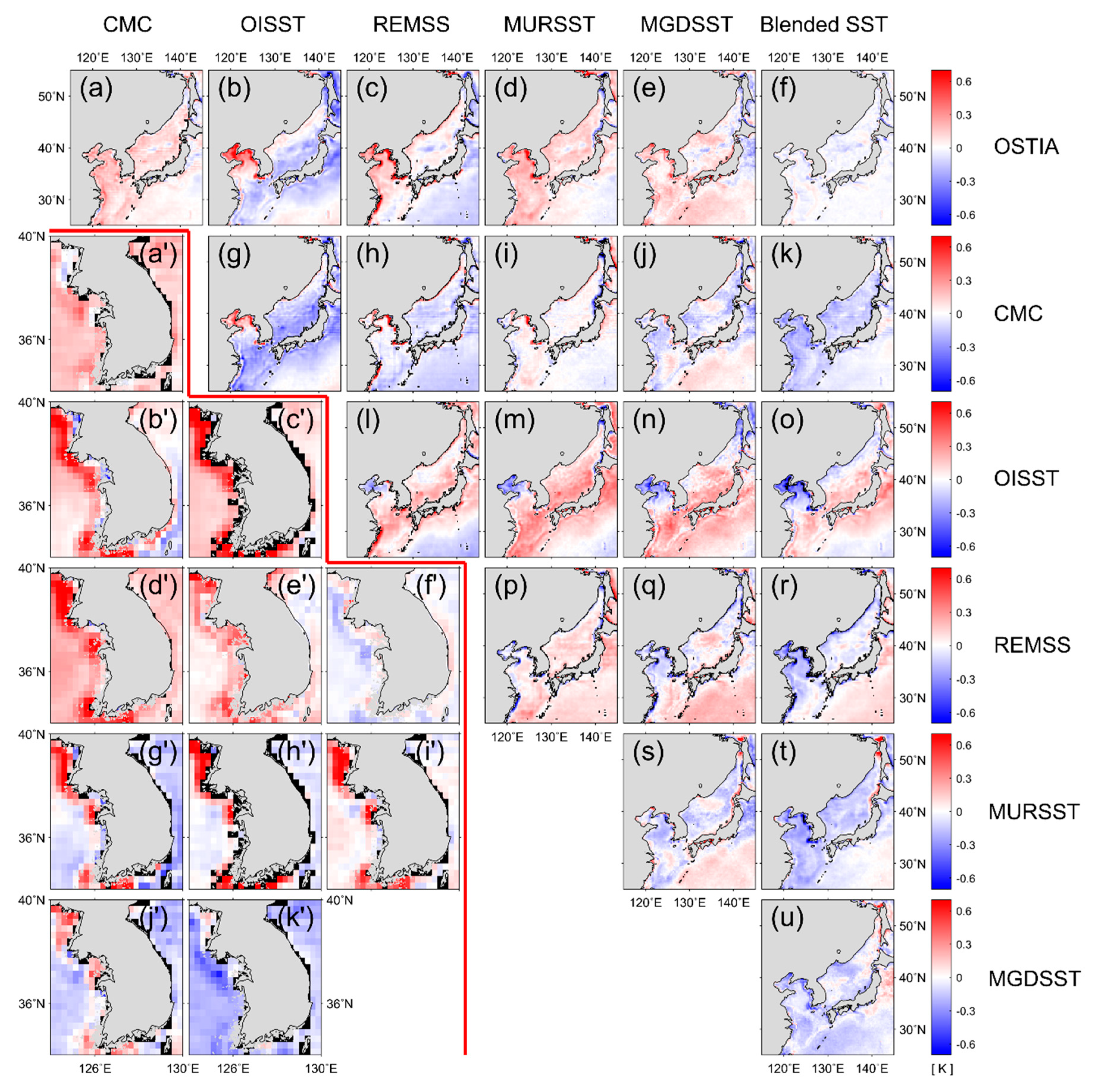
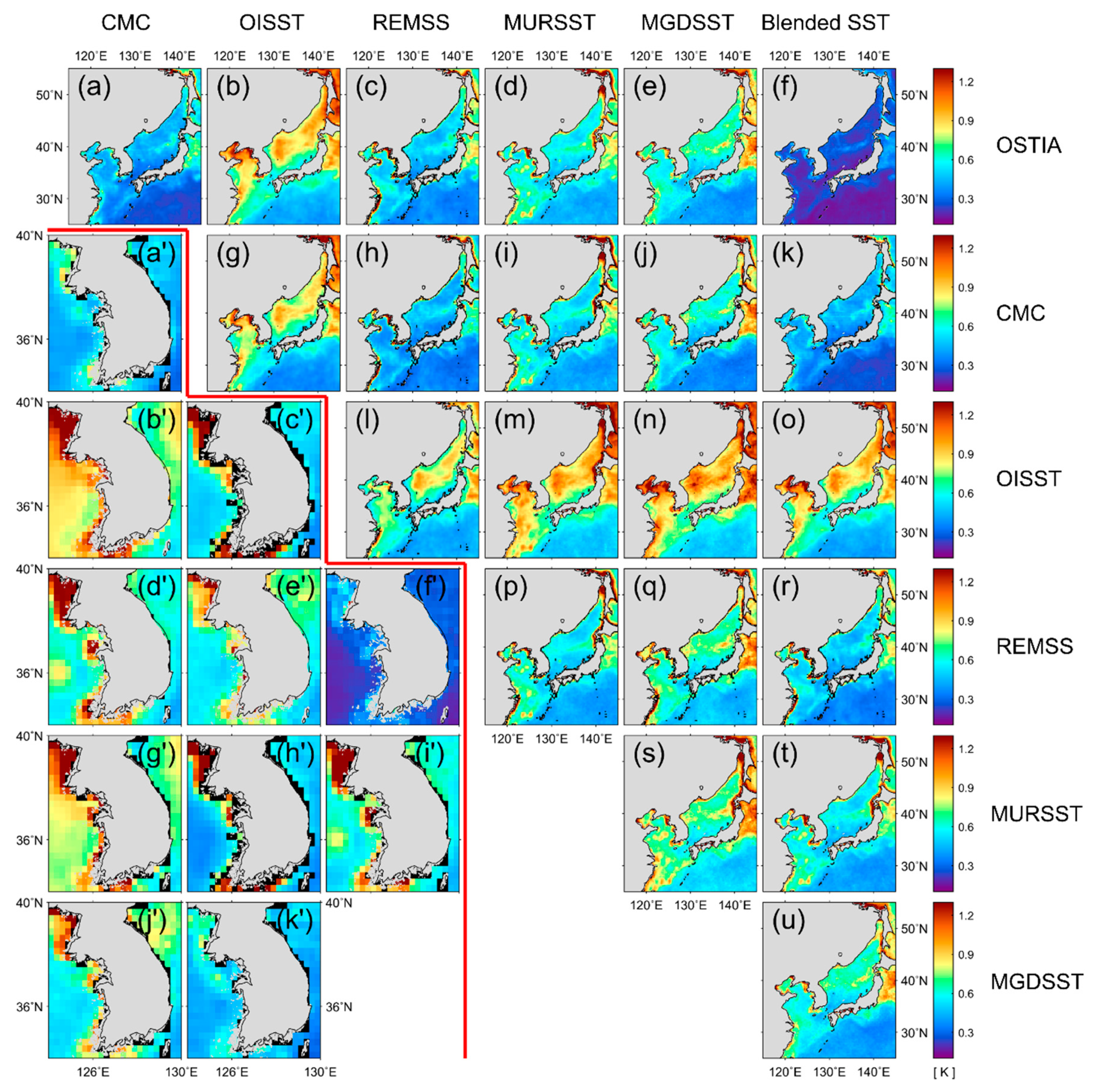

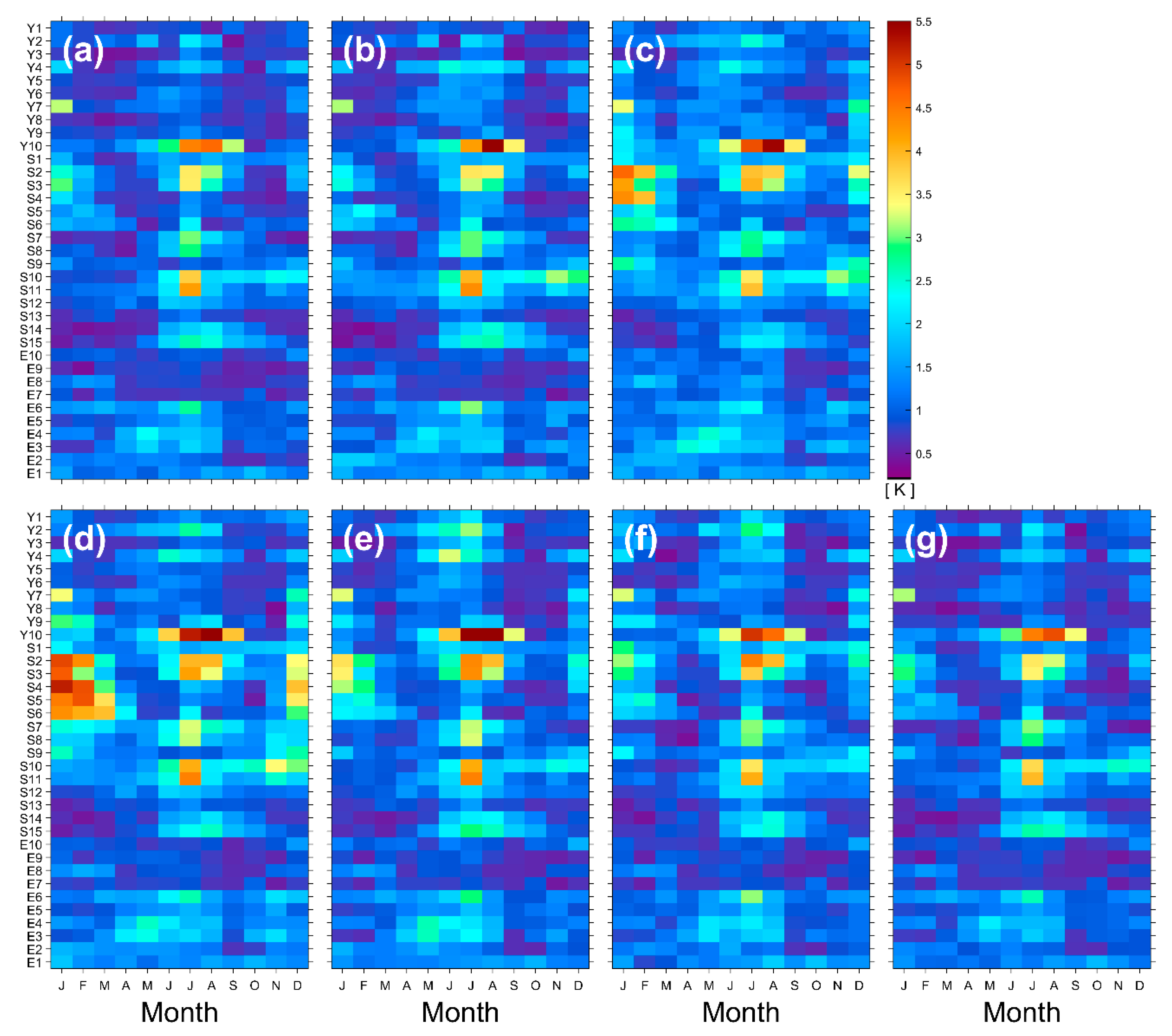
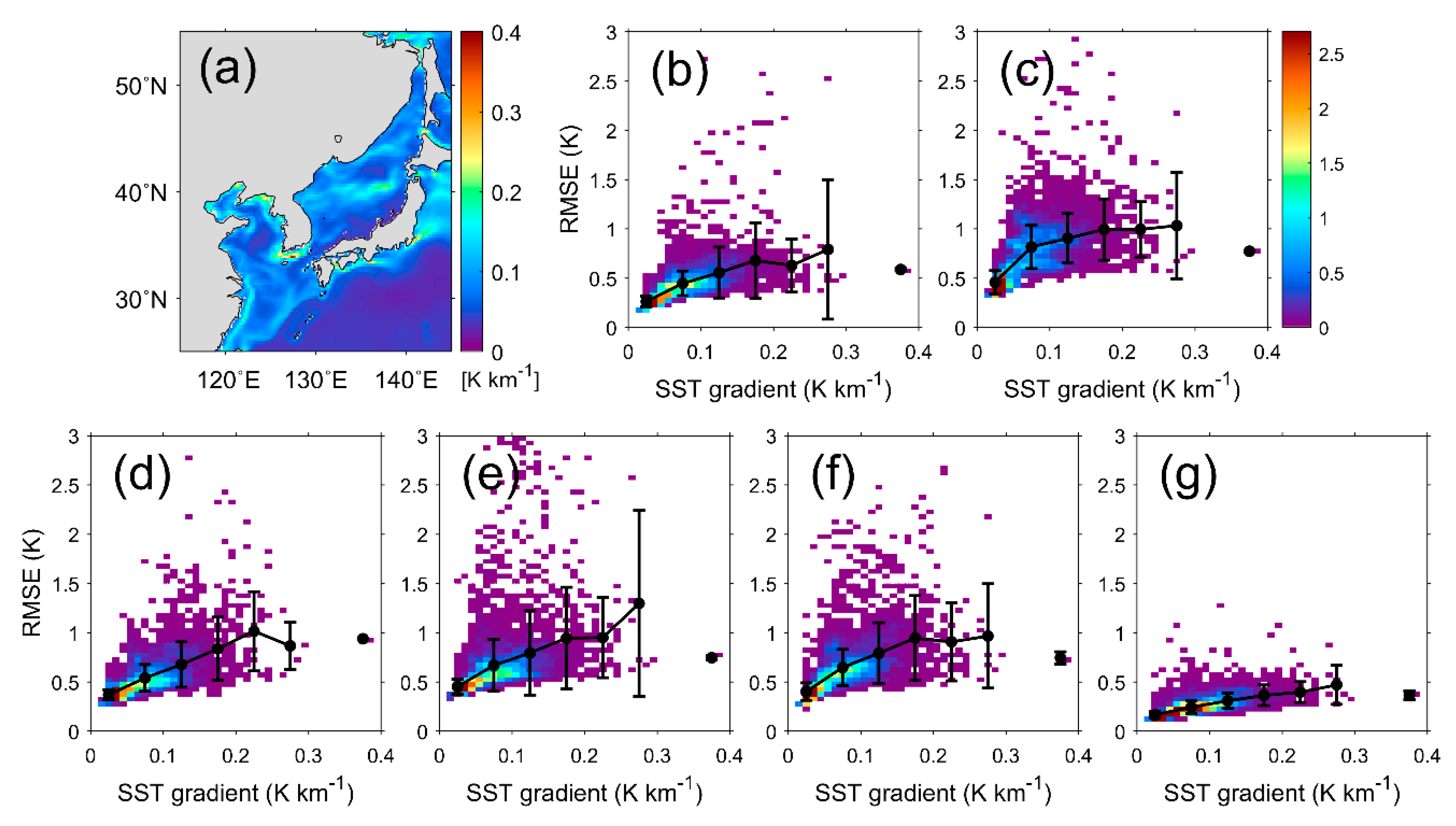
| Name | Period | Spatial resolution (°) | Input data | Agency | ||
|---|---|---|---|---|---|---|
| IR | MW | In-situ | ||||
| OSTIA | Jan 2007–present | 0.05 | AVHRR, IASI, SEVIRI, GOES13 Imager | TMI | GTS | Met Office |
| CMC analysis | Sep 1991–present | 0.2 (~2017) 0.1 (2016~) | AVHRR | Windsat | GTS | CMC |
| OISST | Sep 1981–present | 0.25 | AVHRR | - | GTS | NCEI/NOAA |
| REMSS analysis | Jun 2002–present | 0.09 | MODIS | AMSR2, TMI, Windsat | - | REMSS |
| MURSST | Jun 2002–present | 0.01 | AVHRR, MODIS | AMSR2 | iQUAM | JPL/NASA |
| MGDSST | Jan 1982–present | 0.25 | AVHRR | AMSR-E, Windsat, AMSR2 | GTS | JMA |
| Blended SST | Sep 2002–present | 0.05 | AVHRR, JAMI, GOES Imager | - | - | NESDIS/NOAA |
| Region | Symbol | Station Name | Depth (m) | Distance from the Coast (km) |
|---|---|---|---|---|
| East/Japan Sea | E1 | Toseong | 27 | 2.97 |
| E2 | Yeongok | 29 | 3.00 | |
| E3 | Samcheok | 19 | 1.11 | |
| E4 | Jukbyeon | 29 | 0.55 | |
| E5 | Hupo | 29.5 | 1.20 | |
| E6 | Guryongpo | 31 | 1.10 | |
| E7 | Hyeolam | 21 | 0.43 | |
| E8 | Guam | 34 | 1.05 | |
| E9 | Ulleungup | 26 | 0.30 | |
| E10 | Dokdo | 30 | 1.59 | |
| Southern region | S1 | Chujado | 32 | 0.22 |
| S2 | Nohwado | 18.6 | 3.61 | |
| S3 | Cheongsando | 40 | 1.77 | |
| S4 | Goheung | 19 | 1.50 | |
| S5 | Geumodo | 30 | 1.12 | |
| S6 | Dumido | 30 | 2.14 | |
| S7 | Hansando | 50 | 3.08 | |
| S8 | Haegeumgang | 45 | 0.18 | |
| S9 | Namhang | 20 | 2.25 | |
| S10 | Bukhang | 40 | 0.75 | |
| S11 | Jangan | 28 | 2.20 | |
| S12 | Gapado | 19 | 0.28 | |
| S13 | Jungmun | 29 | 1.49 | |
| S14 | Jejuhang | 37 | 1.35 | |
| S15 | Udo | 30 | 0.51 | |
| Yellow Sea | Y1 | Jawoldo | 30 | 4.68 |
| Y2 | Ijakdo | 31 | 3.66 | |
| Y3 | Pungdo | 51 | 0.14 | |
| Y4 | Sinjindo | 16.5 | 4.48 | |
| Y5 | Sangsido | 19 | 1.39 | |
| Y6 | Seochun | 21 | 9.65 | |
| Y7 | Gunsan | 34 | 3.06 | |
| Y8 | Yeonggwang | 16.5 | 13.36 | |
| Y9 | Okdo | 19 | 1.89 | |
| Y10 | Jindo | 26 | 1.20 |
| SST Analysis | Number of Matchups | Bias Error (K) | RMSE (K) | ||||
|---|---|---|---|---|---|---|---|
| Day | Night | Total | Day | Night | Total | ||
| OSTIA | 58617 | 0.2556 | 0.3165 | 0.2859 | 1.2579 | 1.2900 | 1.2674 |
| CMC | 58584 | 0.4157 | 0.4765 | 0.4461 | 1.3476 | 1.3881 | 1.3616 |
| OISST | 58379 | 0.4677 | 0.5289 | 0.4985 | 1.5843 | 1.6163 | 1.5950 |
| REMSS | 58617 | 0.7077 | 0.7683 | 0.7381 | 1.7213 | 1.7582 | 1.7352 |
| MURSST | 58617 | 0.4674 | 0.5278 | 0.4977 | 1.4718 | 1.5069 | 1.4838 |
| MGDSST | 58617 | 0.4360 | 0.4966 | 0.4663 | 1.4049 | 1.4402 | 1.4168 |
| Blended SST | 58453 | 0.2839 | 0.3449 | 0.3143 | 1.2620 | 1.2959 | 1.2724 |
© 2020 by the authors. Licensee MDPI, Basel, Switzerland. This article is an open access article distributed under the terms and conditions of the Creative Commons Attribution (CC BY) license (http://creativecommons.org/licenses/by/4.0/).
Share and Cite
Woo, H.-J.; Park, K.-A. Inter-Comparisons of Daily Sea Surface Temperatures and In-Situ Temperatures in the Coastal Regions. Remote Sens. 2020, 12, 1592. https://doi.org/10.3390/rs12101592
Woo H-J, Park K-A. Inter-Comparisons of Daily Sea Surface Temperatures and In-Situ Temperatures in the Coastal Regions. Remote Sensing. 2020; 12(10):1592. https://doi.org/10.3390/rs12101592
Chicago/Turabian StyleWoo, Hye-Jin, and Kyung-Ae Park. 2020. "Inter-Comparisons of Daily Sea Surface Temperatures and In-Situ Temperatures in the Coastal Regions" Remote Sensing 12, no. 10: 1592. https://doi.org/10.3390/rs12101592
APA StyleWoo, H.-J., & Park, K.-A. (2020). Inter-Comparisons of Daily Sea Surface Temperatures and In-Situ Temperatures in the Coastal Regions. Remote Sensing, 12(10), 1592. https://doi.org/10.3390/rs12101592





